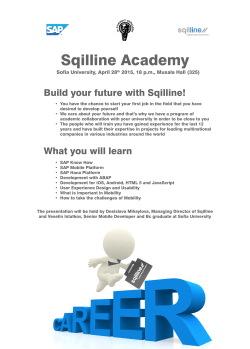
The mobility revolution
The mobility revolution How your organisation can create a competitive advantage through technology About Us • R & G Technologies – established in 2003 currently 30 staff • IT Consulting & support to NFPs throughout Australia • Co-presenters of ConnectingUp Technology Leadership Academy 2005 2013 2014 • NFP landscape is changing – individualized funding, NDIS etc. • Efficiency, client satisfaction and delivery will be paramount • A key driver of success will be defining and harnessing a competitive advantage. So what is mobility and why should I care? • Giving your staff efficient access to necessary files & software on any device, in or outside of their traditional office location ▫ In the field (on-site) ▫ At home ▫ Multiple offices Why does it matter? • Mobility makes you more efficient • Allows you to deliver better service (retain more clients) • Increases staff retention • Ultimately, it can become a competitive advantage for your organisation Two ways to drive mobility • #1 – With IaaS • #2 – With SaaS Driving Mobility – IaaS Local Servers Cloud Infrastructure as a Service (IaaS) Driving Mobility – IaaS • • • • Copy what you already have but add mobility Use your existing software ConnectingUp releasing IaaS in next few months YOU STILL HAVE SERVERS SaaS • SaaS = Software as a Service • Delivery of applications over the internet usually through a web browser • No need for servers, maintenance, upgrades etc. Driving Mobility – SaaS • There are really five key functional areas to address: ▫ ▫ ▫ ▫ ▫ Productivity Suite (Office) File Storage Core Business Applications (CRM, Finance) Device / Workstations Unifying the experience 1. Productivity Suite & 2. File Storage • Office365 is Microsoft’s Cloud product suite including: ▫ Exchange ▫ SharePoint ▫ Lync • SharePoint also doubles as your file server • Heavily integrated into Windows 8 • Alternative is Google Apps & Google Drive 3. Core Business Applications • Utilise SaaS based applications • CRM – Aptify, Blackbaud, Microsoft CRM, Salesforce • eMarketing – Mailchimp, Constant Contact • Accounting – Xero, MYOB Online • Budgeting/Cashflow – Calxa 3. Core Business Applications • Another alternative is to utilise custom software development to write mobile applications • IaaS is needed if you wish to keep using existing windows applications eg. MYOB 4. Devices • • • • • Windows Surface Pro? Tablets? Laptops? Phones? PCs? 5. Unifying the Experience • How will you ensure that the cohesiveness of your organisation is not broken if everyone is “mobile”? • Messaging? Unified Communications? • Information Distribution? Intranet? A typical mobility strategy ▫ ▫ ▫ ▫ ▫ Productivity Suite – Office 365 File Storage - Office 365 (SharePoint & SkyDrive) Core Business Applications (Microsoft CRM) Devices –Windows Surface Pros or Laptops Unify experience – Lync, SharePoint Case Study - Xavier • Disability Services • Multiple offices, multiple systems Case Study - Xavier Case Study - Xavier • Custom developed “Ops System” • Online timesheets SharePoint - Intranet SharePoint – Document/Files Lync What are the costs? • IaaS is generally more expensive than SaaS when considering TCO • Smaller organisations should consider SaaS • With programs like Office 365 charity pricing and ConnectingUp it can be cheaper than you think! Mobility Considerations & Tips • Plan first! Start with an integrated strategy – do it yourself or seek out a consultant who can help • Consider security – MDM, BYOD? • Internet becomes very important! • Mobility often involves cloud computing. You should be comfortable with “the cloud” In conclusion • Mobility is unfortunately not a fad or a “nice to have” • If you’re not embracing mobility your competition probably is Thanks for listening • Questions?
© Copyright 2025










